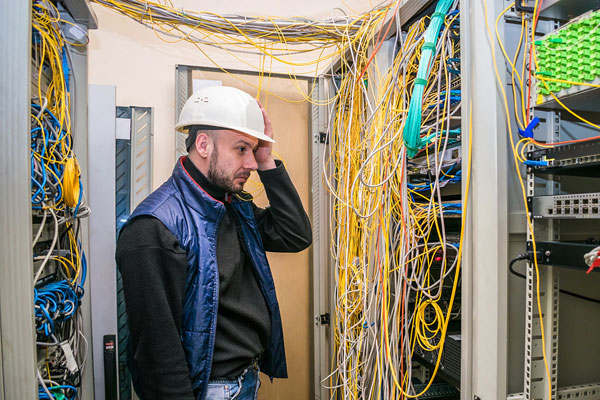Whether you’re setting up an office network for a new building or upgrading your current one, there are multiple steps to take and processes to follow, often under tight deadlines.
Unfortunately, the race to finish the job often leads to short cuts and mistakes, and often cable management is one of the areas that gets overlooked. If not properly determined, designed, and installed, improper network cabling can lead to maintenance headaches, repair costs and even downtime. Here are five common cable management mistakes to avoid when setting up or revamping your network:
Not planning for the future
When you’re determining your cable count for today’s needs, you should also calculate what your future demands will be. Communication and electrical pathways are static components and have life expectancies far greater than that of the cabling system they contain. And as systems continue to converge and expand with new emerging applications, the amount of cables you’ll need is certain to grow. It is more time- and cost-efficient to install a larger cable tray now then to have to upgrade your network infrastructure later.
Not supporting the cable tray correctly
The failure to properly install a cable tray can result in safety implications ranging from a failure to properly secure the cables to a total collapse of the trays. VE2 is a National Electrical Manufacturers Association (NEMA) standard that outlines cable tray installation practices. Section 3: “Installation” describes the many types of supports as well as details on how to install them. Key areas such as where to locate supports for straight sections and fittings as well as where to locate splice joints are also covered. In VE2, the standard provides charts that calculate how often expansion joints are required and how to properly set the gap for expansion connectors as well as locations for hold down clamps and expansion guides.
Improper choice of cable tray
There are many different types of cable trays available, from ladder to ventilated trough to wire basket to solid bottom. Knowing the type of cable and the environment in which it will be installed will determine the choice of cable tray you need. For example, single conductor cables must be installed in a ladder or ventilated trough. Solid bottom trays would only normally be specified where EMI/RFI shielding protection is a concern. Low voltage telecom cables, control and AV cables are traditionally installed in wire basket cable trays. Weight capacity and cable volume of the tray must be calculated in order to specify the correct tray criteria. Trays requiring greater span distances will require a greater cross sectional area for the side rails. It’s vital that you fully understand all aspects of your installation in order to know which cable tray will do the best job.
Incorrect grounding and bonding
Aluminum and steel cable tray systems are excellent equipment grounding conductors as long as they are properly designed, installed and inspected. These types of cable trays are permitted to be used as an equipment ground conductor (EGC), per NEC 392, when labeled as such as well as marked with the available cross sectional area.If the cable tray is to be used as an EGC, bonding jumpers must be installed on both side rails at each tray joint, unless the splice plates meet the electrical continuity requirements of NEMA VE1. If the tray connections are UL Classified, bonding jumpers or continuous ground components are not required. It is important that the grounding of cable tray systems, including the cables in the tray, is inspected before the cabling in the tray is energized and before cable is installed. This will help to eliminate any dangerous situation that may occur due to improper bonding.
Calculate a proper fill ratio for the cable tray you are using
Overfilling a cable tray can lead to poor cable performance, damage and could become a safety hazard. NEC 392.20-22 outlines the requirements for installing cables within cable trays by taking the size, voltage and numbers of conductors into account in order to develop the correct fill ratio of cables in relation to the tray’s cross sectional area. Where low voltage communication cables are used typically either a 40 or 50% rule is in effect. For electrical cables it becomes much more stringent due to safety issues associated with higher voltages. Typically, the sum of the diameters of all single conductor cables shall not exceed the cable tray width, and the cables shall be installed in a single layer.
Learn More
If you’re looking for a tray system to support your current or upcoming cable management requirements, contact Snake Tray today. We’re happy to answer any questions you have, and we will work with you to find the right products and services necessary to meet your network installation or upgrade needs, all at a price you can afford.

